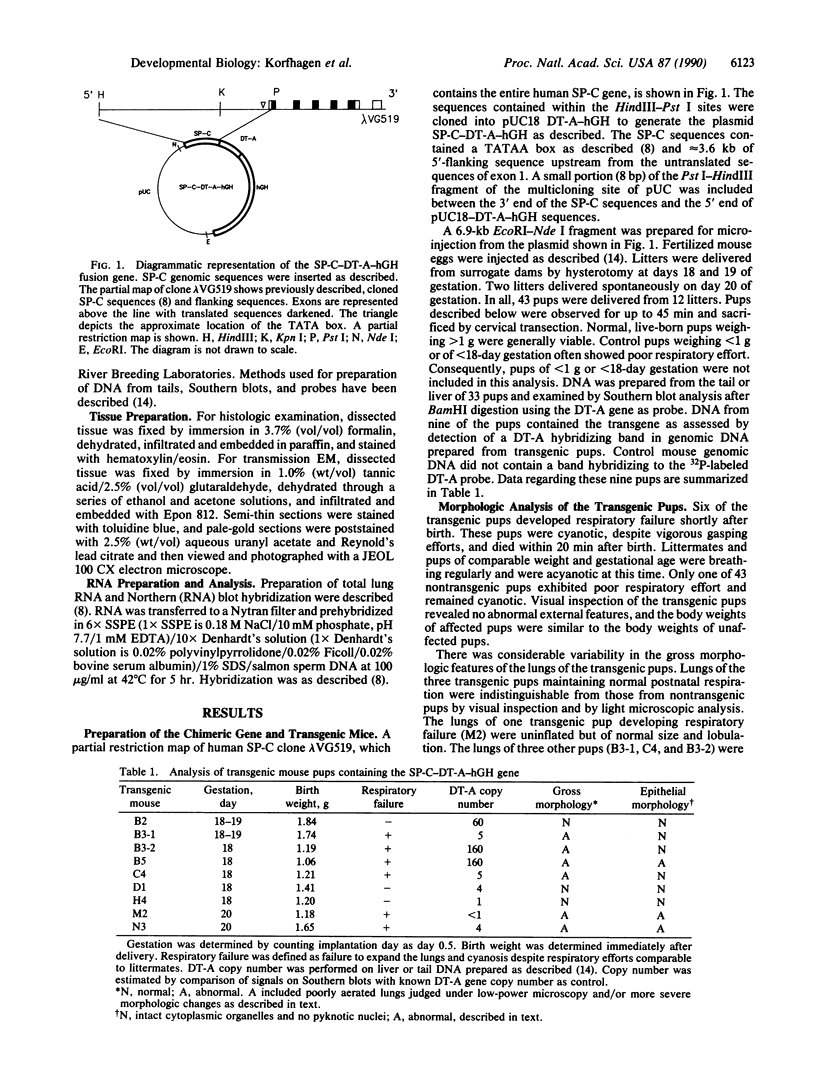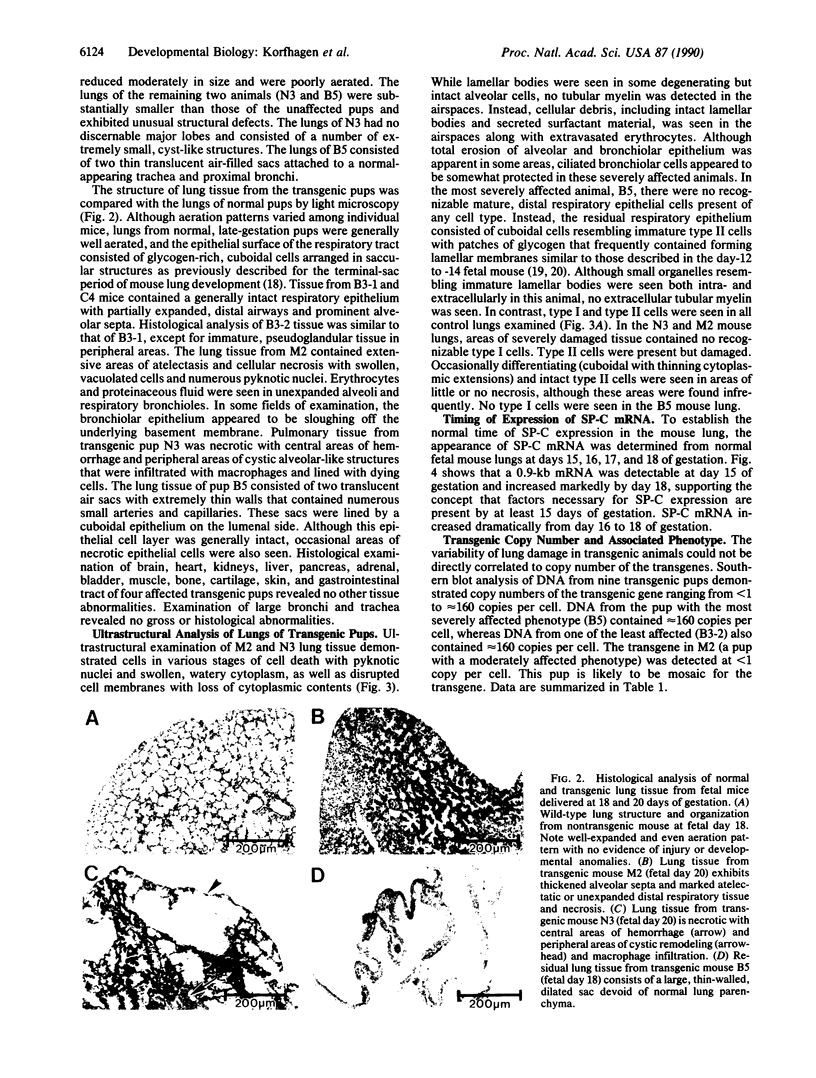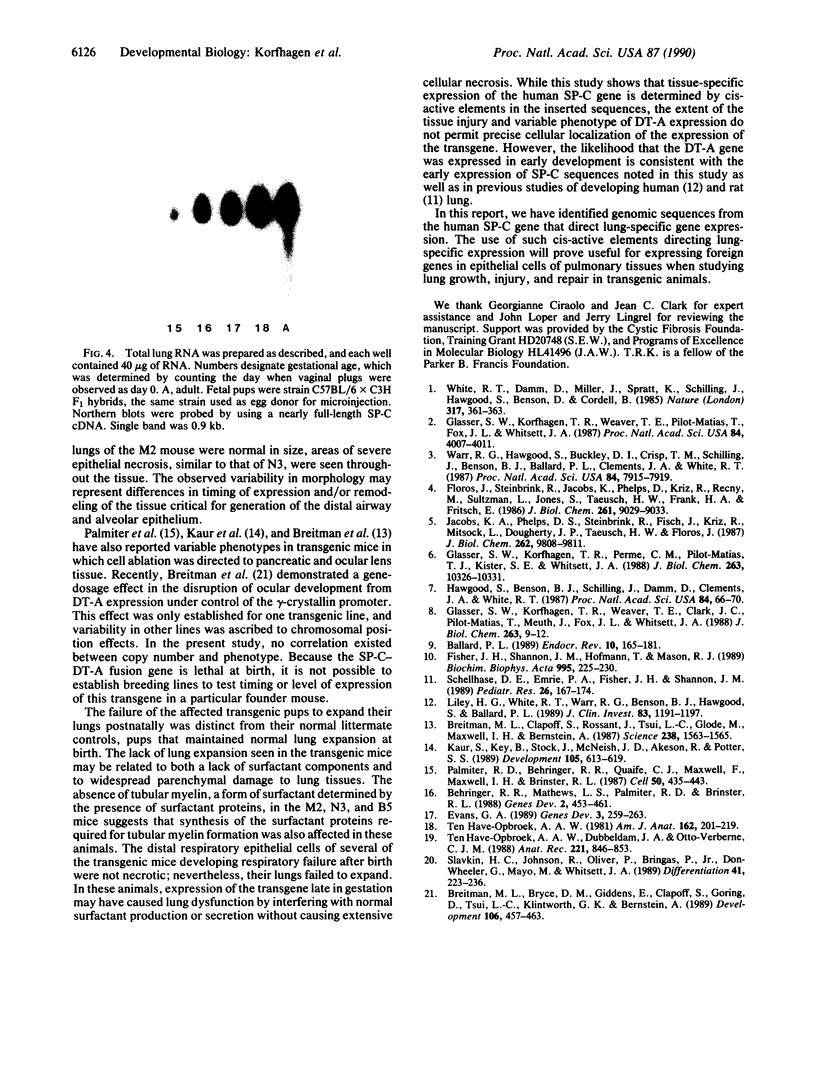Abstract
Pulmonary surfactant is produced in late gestation by developing type II epithelial cells lining the alveolar epithelium of the lung. Lack of surfactant at birth is associated with respiratory distress syndrome in premature infants. Surfactant protein C (SP-C) is a highly hydrophobic peptide isolated from pulmonary tissue that enhances the biophysical activity of surfactant phospholipids. Like surfactant phospholipid, SP-C is produced by epithelial cells in the distal respiratory epithelium, and its expression increases during the latter part of gestation. A chimeric gene containing 3.6 kilobases of the promoter and 5'-flanking sequences of the human SP-C gene was used to express diphtheria toxin A. The SP-C-diphtheria toxin A fusion gene was injected into fertilized mouse eggs to produce transgenic mice. Affected mice developed respiratory failure in the immediate postnatal period. Morphologic analysis of lungs from affected pups showed variable but severe cellular injury confined to pulmonary tissues. Ultrastructural changes consistent with cell death and injury were prominent in the distal respiratory epithelium. Proximal components of the tracheobronchial tree were not severely affected. Transgenic animals were of normal size at birth, and structural abnormalities were not detected in nonpulmonary tissues. Lung-specific diphtheria toxin A expression controlled by the human SP-C gene injured type II epithelial cells and caused extensive necrosis of the distal respiratory epithelium. The absence of type I epithelial cells in the most severely affected transgenic animals supports the concept that developing type II cells serve as precursors to type I epithelial cells.
Full text
PDF




Images in this article
Selected References
These references are in PubMed. This may not be the complete list of references from this article.
- Ballard P. L. Hormonal regulation of pulmonary surfactant. Endocr Rev. 1989 May;10(2):165–181. doi: 10.1210/edrv-10-2-165. [DOI] [PubMed] [Google Scholar]
- Behringer R. R., Mathews L. S., Palmiter R. D., Brinster R. L. Dwarf mice produced by genetic ablation of growth hormone-expressing cells. Genes Dev. 1988 Apr;2(4):453–461. doi: 10.1101/gad.2.4.453. [DOI] [PubMed] [Google Scholar]
- Breitman M. L., Bryce D. M., Giddens E., Clapoff S., Goring D., Tsui L. C., Klintworth G. K., Bernstein A. Analysis of lens cell fate and eye morphogenesis in transgenic mice ablated for cells of the lens lineage. Development. 1989 Jul;106(3):457–463. doi: 10.1242/dev.106.3.457. [DOI] [PubMed] [Google Scholar]
- Breitman M. L., Clapoff S., Rossant J., Tsui L. C., Glode L. M., Maxwell I. H., Bernstein A. Genetic ablation: targeted expression of a toxin gene causes microphthalmia in transgenic mice. Science. 1987 Dec 11;238(4833):1563–1565. doi: 10.1126/science.3685993. [DOI] [PubMed] [Google Scholar]
- Evans G. A. Dissecting mouse development with toxigenics. Genes Dev. 1989 Mar;3(3):259–263. doi: 10.1101/gad.3.3.259. [DOI] [PubMed] [Google Scholar]
- Fisher J. H., Shannon J. M., Hofmann T., Mason R. J. Nucleotide and deduced amino acid sequence of the hydrophobic surfactant protein SP-C from rat: expression in alveolar type II cells and homology with SP-C from other species. Biochim Biophys Acta. 1989 May 1;995(3):225–230. doi: 10.1016/0167-4838(89)90040-x. [DOI] [PubMed] [Google Scholar]
- Floros J., Steinbrink R., Jacobs K., Phelps D., Kriz R., Recny M., Sultzman L., Jones S., Taeusch H. W., Frank H. A. Isolation and characterization of cDNA clones for the 35-kDa pulmonary surfactant-associated protein. J Biol Chem. 1986 Jul 5;261(19):9029–9033. [PubMed] [Google Scholar]
- Glasser S. W., Korfhagen T. R., Perme C. M., Pilot-Matias T. J., Kister S. E., Whitsett J. A. Two SP-C genes encoding human pulmonary surfactant proteolipid. J Biol Chem. 1988 Jul 25;263(21):10326–10331. [PubMed] [Google Scholar]
- Glasser S. W., Korfhagen T. R., Weaver T. E., Clark J. C., Pilot-Matias T., Meuth J., Fox J. L., Whitsett J. A. cDNA, deduced polypeptide structure and chromosomal assignment of human pulmonary surfactant proteolipid, SPL(pVal). J Biol Chem. 1988 Jan 5;263(1):9–12. [PubMed] [Google Scholar]
- Glasser S. W., Korfhagen T. R., Weaver T., Pilot-Matias T., Fox J. L., Whitsett J. A. cDNA and deduced amino acid sequence of human pulmonary surfactant-associated proteolipid SPL(Phe). Proc Natl Acad Sci U S A. 1987 Jun;84(12):4007–4011. doi: 10.1073/pnas.84.12.4007. [DOI] [PMC free article] [PubMed] [Google Scholar]
- Hawgood S., Benson B. J., Schilling J., Damm D., Clements J. A., White R. T. Nucleotide and amino acid sequences of pulmonary surfactant protein SP 18 and evidence for cooperation between SP 18 and SP 28-36 in surfactant lipid adsorption. Proc Natl Acad Sci U S A. 1987 Jan;84(1):66–70. doi: 10.1073/pnas.84.1.66. [DOI] [PMC free article] [PubMed] [Google Scholar]
- Jacobs K. A., Phelps D. S., Steinbrink R., Fisch J., Kriz R., Mitsock L., Dougherty J. P., Taeusch H. W., Floros J. Isolation of a cDNA clone encoding a high molecular weight precursor to a 6-kDa pulmonary surfactant-associated protein. J Biol Chem. 1987 Jul 15;262(20):9808–9811. [PubMed] [Google Scholar]
- Kaur S., Key B., Stock J., McNeish J. D., Akeson R., Potter S. S. Targeted ablation of alpha-crystallin-synthesizing cells produces lens-deficient eyes in transgenic mice. Development. 1989 Mar;105(3):613–619. doi: 10.1242/dev.105.3.613. [DOI] [PubMed] [Google Scholar]
- Liley H. G., White R. T., Warr R. G., Benson B. J., Hawgood S., Ballard P. L. Regulation of messenger RNAs for the hydrophobic surfactant proteins in human lung. J Clin Invest. 1989 Apr;83(4):1191–1197. doi: 10.1172/JCI114000. [DOI] [PMC free article] [PubMed] [Google Scholar]
- Palmiter R. D., Behringer R. R., Quaife C. J., Maxwell F., Maxwell I. H., Brinster R. L. Cell lineage ablation in transgenic mice by cell-specific expression of a toxin gene. Cell. 1987 Jul 31;50(3):435–443. doi: 10.1016/0092-8674(87)90497-1. [DOI] [PubMed] [Google Scholar]
- Schellhase D. E., Emrie P. A., Fisher J. H., Shannon J. M. Ontogeny of surfactant apoproteins in the rat. Pediatr Res. 1989 Sep;26(3):167–174. doi: 10.1203/00006450-198909000-00001. [DOI] [PubMed] [Google Scholar]
- Slavkin H. C., Johnson R., Oliver P., Bringas P., Jr, Don-Wheeler G., Mayo M., Whitsett J. A. Lamellar body formation precedes pulmonary surfactant apoprotein expression during embryonic mouse lung development in vivo and in vitro. Differentiation. 1989 Sep;41(3):223–236. doi: 10.1111/j.1432-0436.1989.tb00751.x. [DOI] [PubMed] [Google Scholar]
- Ten Have-Opbroek A. A., Dubbeldam J. A., Otto-Verberne C. J. Ultrastructural features of type II alveolar epithelial cells in early embryonic mouse lung. Anat Rec. 1988 Aug;221(4):846–853. doi: 10.1002/ar.1092210409. [DOI] [PubMed] [Google Scholar]
- Ten Have-Opbroek A. A. The development of the lung in mammals: an analysis of concepts and findings. Am J Anat. 1981 Nov;162(3):201–219. doi: 10.1002/aja.1001620303. [DOI] [PubMed] [Google Scholar]
- Warr R. G., Hawgood S., Buckley D. I., Crisp T. M., Schilling J., Benson B. J., Ballard P. L., Clements J. A., White R. T. Low molecular weight human pulmonary surfactant protein (SP5): isolation, characterization, and cDNA and amino acid sequences. Proc Natl Acad Sci U S A. 1987 Nov;84(22):7915–7919. doi: 10.1073/pnas.84.22.7915. [DOI] [PMC free article] [PubMed] [Google Scholar]
- White R. T., Damm D., Miller J., Spratt K., Schilling J., Hawgood S., Benson B., Cordell B. Isolation and characterization of the human pulmonary surfactant apoprotein gene. 1985 Sep 26-Oct 2Nature. 317(6035):361–363. doi: 10.1038/317361a0. [DOI] [PubMed] [Google Scholar]











